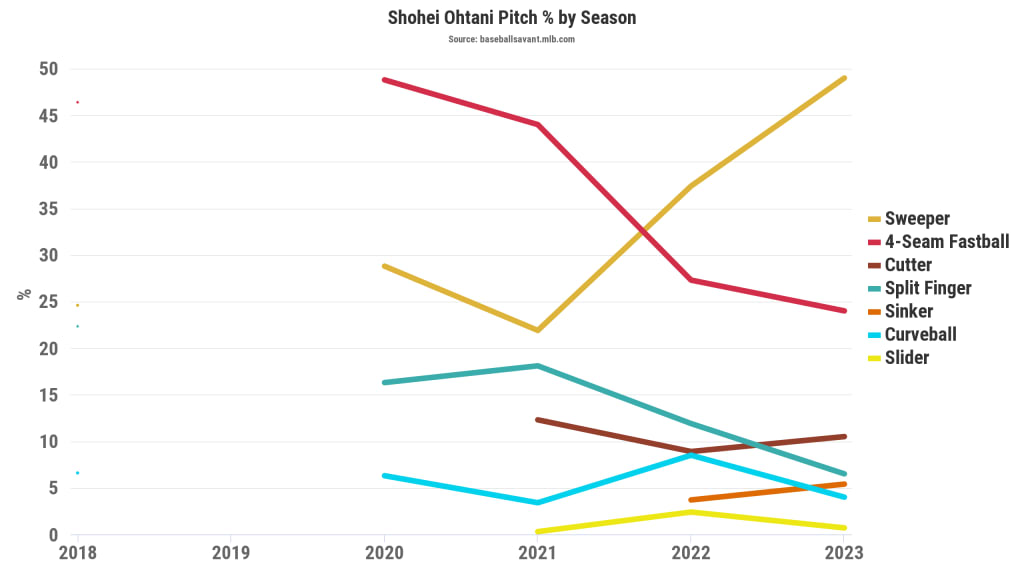If you were told that Shohei Ohtani is fast, the correct answer would be, “Well, you’re going to have to be more specific.”
His fastball is fast, obviously; it averages 97 mph. His bat is fast; over the past three seasons, only three batters have mashed more balls at 115 mph or more. His feet are fast, too; last season, no regular player had a faster home-to-first time than his 4.09 seconds.
But in the context of baseball in 2023, fast means something else, too. Thanks to the new pitch timer, which has cut 27 minutes off the average time of game without sacrificing any action, every pitcher in the sport has needed to get moving just a little bit faster -- and they mostly all have. Yet, even within that sport-wide context, just about no starting pitcher has increased their pitching pace by as much as Ohtani has. It is, apparently, just another thing he does as well or better than most anyone else.
Let’s put some numbers to this. Last year, with the bases empty, Ohtani took 21.7 seconds between pitch releases. (Let’s clarify here: This is not exactly the same as the way the pitch timer works. This number shows time between the release of consecutive pitches, which is a good estimate of pitcher speed, but is not going to be a 1:1 match to the way 2023’s rules work.) That was the third slowest of any regular Angels pitcher last year and slower than something like 90% of all qualified pitchers.
This year, he’s down to 15.3 seconds, a drop of 6.4 seconds. He's now an average Angels pitcher, pace-wise, and he's only ever so slightly slower than the Major League average, as opposed to being quite near the bottom.
It's an impressive change, and it stands out among his peers. Taking all the pitchers who had at least 100 pitches with the bases empty both last year and this year … that’s the third-largest drop, both on a raw basis and by percentage.
Largest drops in bases-empty pitch tempo, 2022-23
-8.0 seconds // Michael Kopech (from 21.1 to 13.1)
-7.2 seconds // Tanner Houck (from 20.3 to 13.1)
-6.4 seconds // Shohei Ohtani (from 21.7 to 15.3)
-5.2 seconds // Tylor Megill (from 19.3 to 14.3)
-5.0 seconds // Lance Lynn (from 19.3 to 14.3)
What you’re getting, then, is more Ohtani in less time, which seems like a win/win for everyone.
But we’re not getting any less performance, are we? Quite the contrary, really. Ohtani has allowed all of two earned runs in his first five starts (0.64 ERA), and the .092 opposing batting average he’s allowed is merely the lowest in a pitcher’s first five starts in the history of anything resembling modern baseball, as MLB.com’s Sarah Langs outlined recently, and his next start, on Thursday afternoon, comes against the 23rd-ranked offense of the Oakland A's.
Yet while he is working faster, he’s also working slower. What we mean by that is two things, really. First, he’s throwing that high-powered fastball less than ever, down to a career-low 24%. Second, as he’s massively upped the usage on the sweeping slider he favors as his primary pitch -- it’s up to 49% usage, more than double the 21% it was two years ago -- he’s also slightly dropped the velocity on it, from 85.3 mph to 83.5 mph.

Take that combination -- the fastball is seen less, and the sweeper is thrown slower – and what you can come up with is the fact that the percentage of pitches we see thrown 85 mph or below from him is up considerably from a year ago.
Ohtani's % of pitches 85 mph or below
2022 // 25%
2023 // 46%
It doesn’t exactly make him Zack Greinke or Rich Hill, famous soft-tossers after all these years in the bigs, but that number does put him in the highest 20% of regular starting pitchers this year -- except most of those guys can’t also pull 100 mph out of their back pocket, as Ohtani can.
So, has this mattered? The results are inconclusive this early in the year, when pitchers have made just a few starts and one bad outing can really torpedo your entire season line, but there is at least one interesting nugget to pass along. If we take the 10 pitchers who have cut the least time from last year, they have as a group performed almost the same. If we take the 10 pitchers who have cut the most time -- i.e., Ohtani and nine others -- they’ve performed much worse, dropping from a .291 wOBA to a .330 mark.
Except, of course, Ohtani (and, also from that group, Toronto’s Yusei Kikuchi).
“I feel like I'm being a little bit rushed,” Ohtani said back in Spring Training, after getting his first taste of the pitch timer, “but as long as I keep on getting games under my belt, I’ll be fine.”
He has. And he is. He’s speeding up to slow down. It's working out wonderfully.
